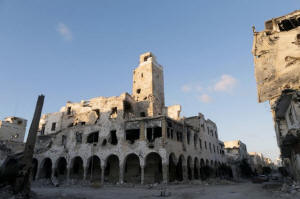|
Benghazi looks to preserve historic
buildings shattered by war
 Send a link to a friend
Send a link to a friend
 [March 10, 2018]
By Ayman al-Warfalli [March 10, 2018]
By Ayman al-Warfalli
BENGHAZI, Libya (Reuters) - In Benghazi's
historic center, many of the landmark Ottoman and Italian-era buildings
have been wrecked by years of war.
Officials say they are determined to restore this architectural
heritage, but face a daunting challenge in a country with a crippled
economy still mired in conflict and politically divided.
"The municipal council's goal is to restore any building that still has
its soul to its natural state," said Osama al-Kaza, projects manager at
the city authority. He has his work cut out.
The front of the Italian-built palace from which King Idris declared
Libya's independence from Italy in 1951 is riddled with bullet and shell
holes, its wooden window frames blown out and its plaster blackened by
smoke.
In a building dating to 1865 that housed the city's first printing
press, a carved stone doorway has been filled with grey breeze blocks
and the facade is badly chipped.

Historic Ottoman-era mosques lie empty and strewn with debris.
Benghazi, about 650 km (400 miles) east of the capital Tripoli, is where
Libya's uprising started seven years ago, triggering a nationwide revolt
that toppled Muammar Gaddafi after four decades in power.
That moment of hope was soon eclipsed as Libya fell into turmoil and
Benghazi witnessed a campaign of bombings and assassinations, followed
by a war that lasted from 2014 until late 2017.
The eastern-based Libyan National Army (LNA) fought Islamists and other
opponents in protracted street battles in parts of the city. The final
months of fighting were focused in the Benghazi's oldest neighborhoods
between the city center and the port.
[to top of second column]
|

A historic building, that was ruined during a three-year conflict,
is seen in Benghazi, Libya February 28, 2018. REUTERS/Esam Omran
Al-Fetori

The LNA used heavy artillery and air strikes to try to root out
rival fighters holed up in downtown residential streets.
The LNA's opponents used bombs and booby traps, some of which are
yet to be cleared so that residents can return and reconstruction
work begin.
The city is due to stage international conference this month in an
effort to drum up support for the restoration effort.
"We need to bring the old city back to life and mobilize all our
efforts and endowments," said Benghazi historian and writer Fathi
al-Sahli. "The situation isn't easy and will require billions" of
Libyan dinars of funding.
"These buildings show that Benghazi had a special cultural legacy.
As guardians of Benghazi we hold the competent authorities
responsible for maintaining these buildings and we will not let them
disappear."
(Writing by Aidan Lewis; Editing by Andrew Heavens)
[© 2018 Thomson Reuters. All rights
reserved.]
Copyright 2018 Reuters. All rights reserved. This material may not be published,
broadcast, rewritten or redistributed.
Thompson Reuters is solely responsible for this content.

 |